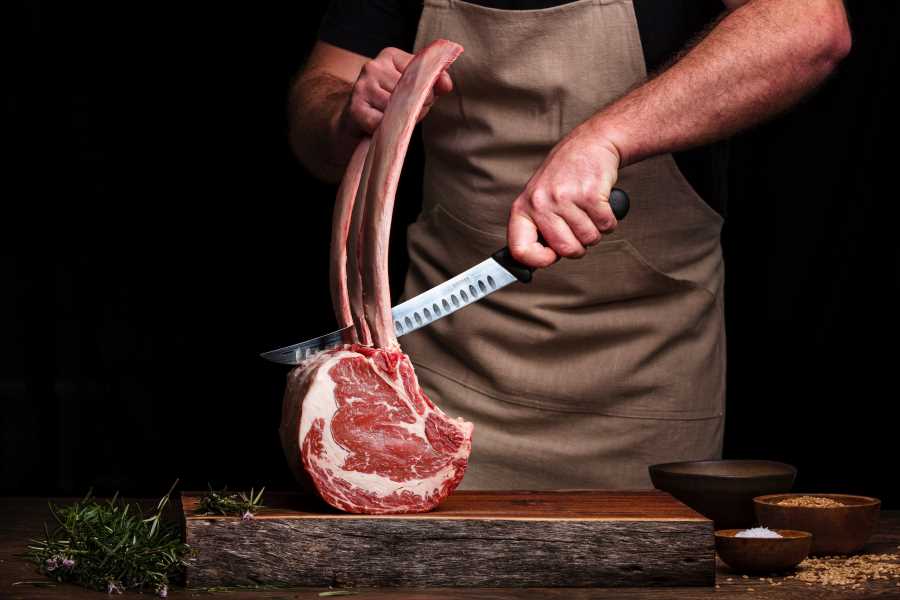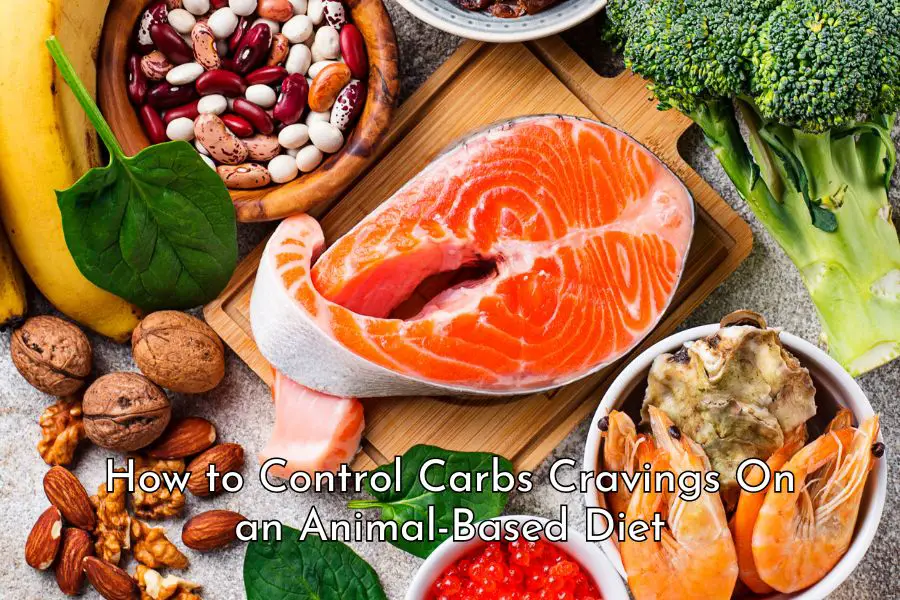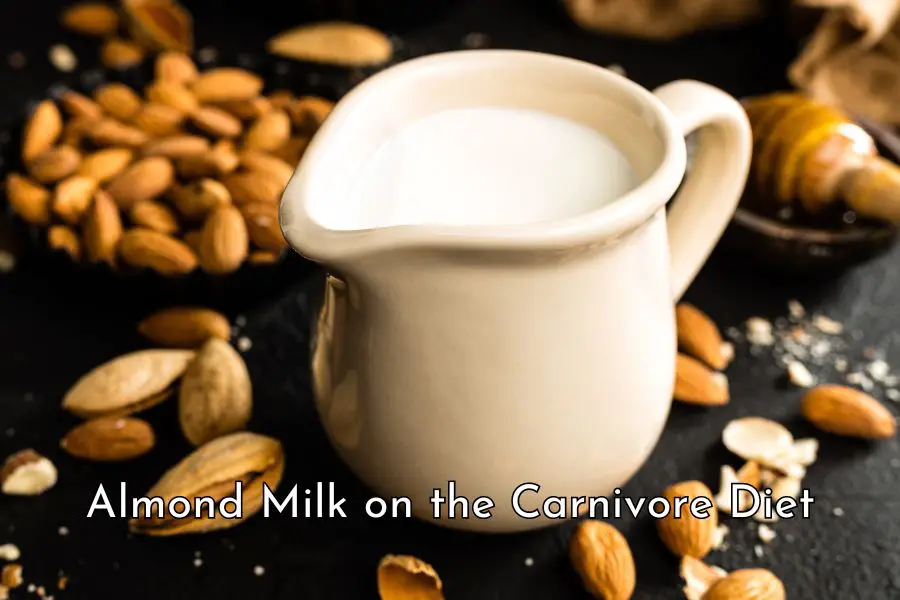You are interested in the carnivore diet but concerned about its safety in the long term. After all, the carnivore diet is a meat-based diet and meat has been controversially linked to an increased risk of heart disease, cancer, diabetes, and even premature death. So, what is the truth? Is the carnivore diet safe?
Based on available evidence, the carnivore diet is safe because i) there is no risk of malnutrition if done properly, ii) there is no evidence that meat causes cancer, heart diseases or diabetes, and iii) our ancestors were hyper-carnivores for two million years and they not only survived but thrived on a heavily meat-based diet.
The remainder of this post will look at each of the arguments and the available evidence in detail.
There is no risk of malnutrition on the carnivore diet if done properly
The carnivore diet is safe because its foods can provide you with all nutrients that your body ever needs. They also come in perfect ratios, are free from plant toxins, highly bio-available, and metabolically friendly (please read this post for further information on why the carnivore diet is healthy).
I challenge you to find an essential nutrient that your body needs and you can’t find it amongst animal source foods.
There is also no risk of malnutrition on the carnivore diet if you do it properly, i.e. closely following the five healthy eating principles listed below which emulate the way our ancestors did for millions of years:
- Eat from a wide variety of animal sources to ensure sufficient nutrients. Eat meat (beef, lamb, goat, bison, pork, chicken etc.), seafood, eggs, bone marrow, bone broth, organ meat, butter, cream, yogurt, and tallow.
- Eat nose-to-tail or as many different parts of an animal as possible. Eating this way will minimize waste while ensuring you have all the necessary materials you need to build a perfectly healthy human body
- Eat from naturally or well-raised animals as much as you can afford (e.g. grass-fed ruminants and pasture-raised pork and chicken)
- Eat unprocessed or minimally processed foods to preserve nutrients and minimize additives
- Eat both cooked and raw if it’s safe and you can tolerate because some nutrients can be destroyed due to prolonged cooking.
Carnivore diet foods are nutrient-dense. They provide a good source of complete proteins, healthy fats, and an abundance of essential vitamins and minerals.
However, opponents of the carnivore diet cite concerns about its potential nutrient deficiency as the reason for it being unsafe. The potential nutrient deficiencies include vitamin C, calcium, vitamin K, vitamin A, folate, and fiber. Let’s explore below whether these concerns are justifiable.
Vitamin C
There is some vitamin C in animal source foods. For more information about the vitamin C contents of animal source foods, please read this post.
For example, there are 1.6 mg and 2.53 mg of vitamin C per 100 grams of fresh pasture and grain-fed beef respectively. [1]
Although the vitamin C contents of animal source foods are low, they are sufficient to meet the 10 mg a day to prevent scurvy, a medical condition associated with vitamin C deficiency. [2]
Furthermore, on the carnivore diet, there would be a negligible amount of glucose intake competing with vitamin C for absorption. Hence you don’t need a lot of vitamin C because whatever you consume would be utilized efficiently. [3, 4]
The Arctic Inuit who lived on the traditional diet of mostly meat (seals, fish, whales, and mussels) all year round and rarely any fruits and vegetables did not suffer from scurvy. [5]
In the 1900s, Vilhjalmur Stefansson, an Arctic explorer who lived on the all-meat diet of the Inuit for nine years, did not get scurvy nor observed other meat-eaters suffering from it. [6, 7]
Scurvy is also not known as a condition associated with the zero carb or keto communities. Esmée La Fleur, who runs the zerocarbzen.com website, interviewed around 40 people on the carnivore diet and reported that none of those interviewed “have experienced any symptoms of vitamin C deficiency, even after 2-18 years of eating this way”. [8, 9]
If you eat a variety of animal foods, eat nose-to-tail and incorporate raw or lightly cooked foods in your diet, rest assured that there is very little risk of vitamin C deficiency.
Calcium
You can get sufficient calcium on the carnivore diet from many sources including:
- Dairy products. Dairy products (whole milk, yogurt, cream, and cheese) are the number one source of calcium on the carnivore diet, but only if you can tolerate them. Just one cup of full-fat yogurt will give you 296 mg of calcium equivalent to 30% of the recommended daily intake. [10]
- Small fish with bones in. Small fish with bones intact is a great source of calcium. For example, a 100 gram serving of Atlantic sardines will give you 382 mg of calcium or 38% of the recommended daily intake. [11]
- Bones and bone meal. Animal bones are rich in calcium. Dry castle rib bones are estimated as having 20% calcium. [12] If you make bone broth regularly, you can save the bones and use them as a calcium source. A couple of pieces each day will fulfill your calcium need.
- Eggshells. Thirty-nine percent of an eggshell is calcium and because the composition of eggshells is very similar to that of human teeth and bones, eggshells are a good source of non-dairy calcium. [13]
- Bone marrow. Bone marrow is an especially good source of calcium compared to muscle meat. A 100 gram serving of beef steak gives you around 16 mg of calcium, whereas the same serving of bone marrow has 340 mg of calcium, 21 times the amount of calcium in muscle meat. If you don’t eat dairy, adding bone marrow to your carnivore diet can help boost your calcium intake significantly. [14]
- Ruminant meat, poultry, and eggs. These foods have a very small amount of calcium so it is important that you get calcium from other sources.
- Bone broth. Bone broth has very little calcium, but if you cook the bone broth for long enough, like for three or four days and mash up the bones afterward with a potato masher, you will find a lot of small bone fragments at the bottom of the pot that are soft and edible. Eating this thick broth can help boost your calcium intake too.
Please read this post for detailed instructions on how to easily turn eggshells and leftover bones into eggshell powder and bone meal, especially for those of you who are sensitive to dairy products.
Vitamin K
There are two types of vitamin K: vitamin K1 and vitamin K2.
Vitamin K1 (phylloquinone) is found plenty in green leafy vegetables such as kale, mustard greens, Swiss chard, collard greens, beet greens, spinach, and broccoli. [15]
Vitamin K2 (menaquinones), predominantly of bacterial origin, is found in modest amounts in various animal-based and fermented foods like natto, liver, and cheese. [16]
Vitamin K1 from plant sources is poorly absorbed by the human body. For example, the body absorbs only 4% to 17% as much phylloquinone from spinach as from a tablet. Vitamin K2, although less abundant, is found to have ten times the absorption rate of vitamin K1. [17, 18, 19]
Animal source foods have plenty of vitamin K, as shown in the table below, and if you eat a variety of animal source foods, you will get sufficient vitamin K from your diet. [20]
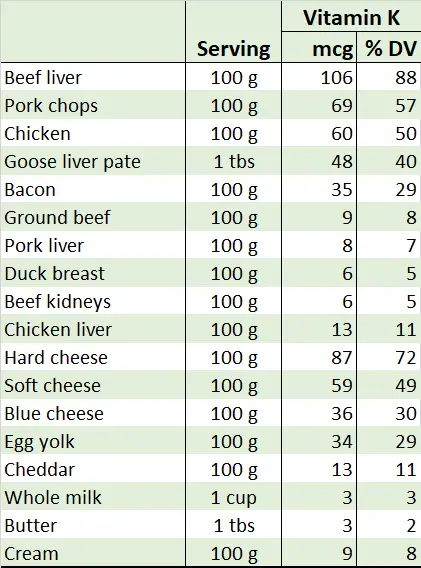
Vitamin A
As can be seen in the table below, there is plenty of vitamin A in animal-sourced foods, especially if you eat organ meat like liver. Just one very small slice of beef liver will deliver the daily recommended intake for vitamin A. [21]
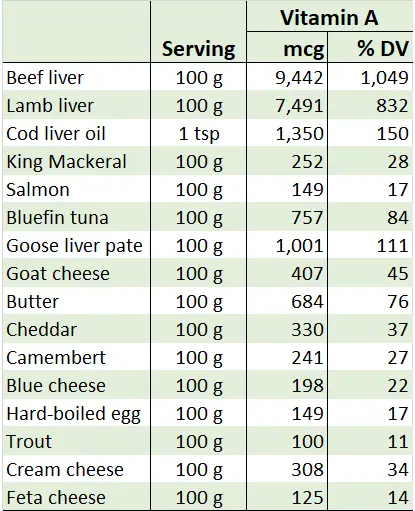
Folate
The table below shows the folate contents of some animal source foods. [22]
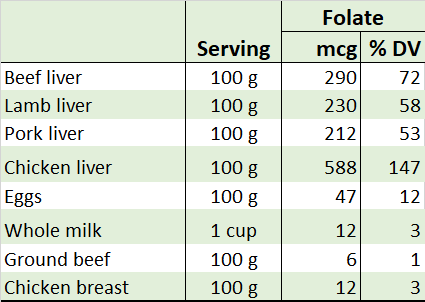
Meat is not a good source of folate. If you have any concerns about your folate intake or are planning for pregnancy, incorporate organ meat, especially liver, and eggs in your meals regularly.
Fiber
Fiber comes from the plant cell walls that provide shapes and architectural supports for the plants. It is unique to plants and doesn’t exist in the human body. [23, 24]
Fiber has zero protein, fat, vitamin or mineral that your body needs. It can’t be digested by your body and is ultimately excreted.
Dr. Tan and Seow-Choen, in a 2007 editorial for the World Journal of Gastroenterology, call fiber “the ultimate junk food. It is neither digestible nor absorbable and therefore devoid of nutrition. People who ingest fiber are ingesting them to make faeces only“. [25]
Claims of health benefits of fiber are generally based on results of epidemiological studies which show an inverse relationship between fiber intake and risk of cancer, cardiovascular disease, diabetes, obesity, and some gastrointestinal diseases. [26, 27, 28, 29]
However, epidemiological studies generally are observational studies that can only show association and can not prove cause and effect.
In a number of controlled trials, fiber is not found to provide protective benefits. [30, 31, 32, 33, 34]
A higher fiber intake will logically result in an increased frequency of evacuation. This creates the fallacy that fiber helps with bowel movements. However, in reality, dietary fiber is not found to improve bowel function.
In contrast, eliminating fiber has actually been found to be beneficial with secretion. In a remarkable study by Ho et al (2012) [35] published in the World Journal of Gastroenterology, 63 patients with idiopathic constipation conditions were put on a no-fiber diet for two weeks. Thereafter, the patients were asked to reduce the amount of dietary fiber intake to a level that they found acceptable.
At six months, 41 patients who remained on a no fiber diet no longer suffered from constipation, bloating, straining, pain and bleeding.
In contrast, the 6 patients who chose to stay on a high-fiber diet still had all of these symptoms.
The 16 patients who were on a reduced fiber diet experienced some improvements accordingly.

Please read this post for more information on why you don’t need fiber on the carnivore diet.
Meat does not cause cancer nor increase other health risks
The carnivore diet is safe because meat does not cause cancer nor increase other health risks.
Epidemiological studies cannot prove causation
Many studies that link higher meat consumption with increased health risks are epidemiological studies or observational studies that can only show association and cannot prove causation.
Epidemiological studies are not scientific experiments. In an epidemiological study, researchers first observe a possible association between a disease and exposure, form a hypothesis about a possible relationship, and then test the hypothesis.
The key problem with epidemiological studies in the nutrition field relates to the quality of data used.
To test their hypothesis, researchers usually have to collect dietary and other lifestyle data from participants using interviews or surveys such as food frequency questionnaires (FFQs), analyze the data, and look for associations between dietary patterns and diseases.
FFQs would typically ask participants questions like the types of foods they eat, the usual frequency of intake, and portion size over a previous period, e.g. week, one month, six months or 12 months. This is subject to considerable measurement error, recall bias, and recall failure, especially when a long recall period is specified. Poor quality data input inevitably produces unreliable results. This is a classic case of rubbish in, rubbish out.
There are also other issues affecting the quality of epidemiological studies like selection bias (i.e. the selection of those who participate in a study and those who do not) and confounding problems (occurring when an observed association is distorted because the exposure is also correlated with another risk factor). [36]
Because epidemiological studies are not scientific experiments, they only show association and can’t prove any cause and effect.
No evidence shows meat causes cancer or other health risks
A rigorous review of current evidence by a 14-member international team led by Dalhousie University and McMaster University in Canada and published in the Annals of Internal Medicine in 2019 recommends that adults continue current unprocessed red meat consumption and current processed meat consumption. [37]
The recommendations were developed using the Nutritional Recommendations guideline development process, which includes rigorous systematic review methodology, and grade methods to rate the certainty of the evidence for each outcome and to move from evidence to recommendations.
Team leader, Bradley Johnston an associate professor of community health at Dalhousie University said “Based on the research, we cannot say with any certainty that eating red or processed meat causes cancer, diabetes or heart disease”. [38]
Professor Johnston also noted that “Among 12 randomised control trials enrolling about 54,000 individuals, we did not find a statistically significant or an important association in the risk of heart disease, cancer, or diabetes for those that consumed less red and processed meat”.
Animal fat does not cause heart disease
Despite what you have been told or heard about the bad ‘saturated fat’, there is no credible evidence of a significant association between saturated fat intake and cardiovascular risk. Instead, saturated fat has been found to have protective benefits. [39, 40]
Furthermore, replacing saturated fats with carbohydrates or omega 6 polyunsaturated fats has made things worse.
An increase in carbohydrate consumption is found paralleling the increased incidence of diabetes and obesity in the USA, while replacing saturated fats with polyunsaturated fats may increase the risk of coronary heart disease, cardiovascular events, death due to coronary heart disease, and overall mortality. [41]
Our ancestors were hyper-carnivores who thrived on a meat-based diet
Based on the totality of evidence: humans were hyper-carnivores for 2 million years
Examining extensive evidence from human physiology and genetics, archeology, paleontology, and zoology, researchers from Tel Aviv University and the University of Minho in Portugal find that humans were definitely not generalist omnivores as previously widely believed. Instead, they were hyper-carnivorous apex predators that ate mostly meat from large animals for 2 million years. [42]
Only the extinction of large mammals due to extensive hunting led to a gradual increase of plant foods in the human diet and ultimately led to the advent of agriculture and humans had to become farmers to survive.
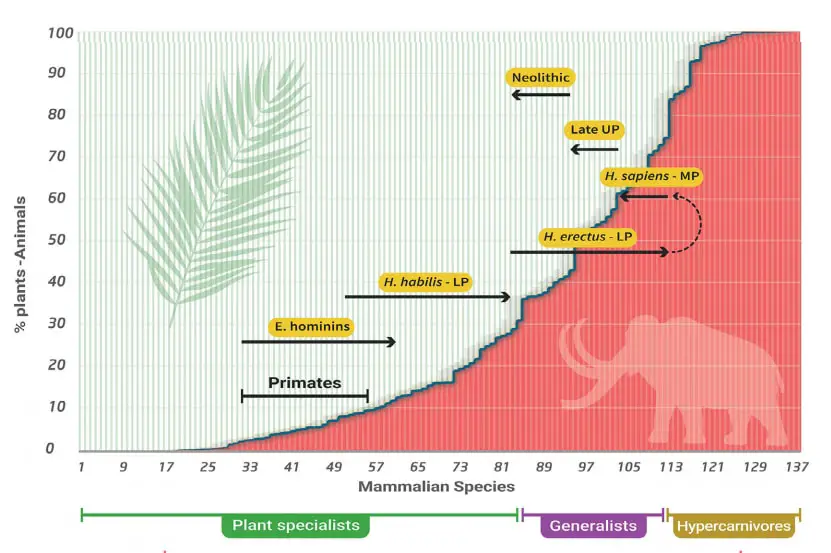
According to Dr Ben-Dor, the lead researcher of the study, human behavior changes rapidly, but evolution is slow and the body remembers. That’s why the researchers rely heavily on current research evidence from biology, namely genetics, metabolism, physiology and morphology. In particular, they find that: [43, 44]
- Stomach acidity. The acidity of the human stomach is even higher than in carnivores, equaling that of scavengers indicating a meat diet in which the acid would provide protection from harmful bacteria.
- Higher fat reserve. Humans have higher body fat reserves than primates and are uniquely adapted to lengthy fasting. This adaptation may have helped with overcoming the erratic encountering of large prey.
- Genetic and metabolic adaptation to a high-fat diet. Humans adapted to higher fat diets, presumably from animals. A study by Swain-Lenz et al. (2019) suggests that “humans shut down regions of the genome to accommodate a high-fat diet while chimpanzees open regions of the genome to accommodate a high sugar diet”
- Diet quality. In primates, a larger brain is associated with high energy density food. With the largest brain among primates, humans are likely to have targeted the highest density food, animal fats, and proteins.
- Insulin resistance. Humans, like carnivores, have a low physiological (non-pathological) insulin sensitivity.
- Gut morphology. Humans’ gut morphology and relative size are radically different from chimpanzees’ gut. Longer small intestines and shorter large intestines are typical of carnivores’ gut morphology and limit humans’ ability to extract energy from plants’ fiber.
- Mastication. Reduction of the masticatory system size already in Homo erectus, compared to early hominins, who relied on terrestrial vegetation as a food source. The reduced size is compatible with meat and fat consumption.
- Age at weaning. Carnivores wean at a younger age, as do humans.
The researchers published their full findings in a study titled “The evolution of the human trophic level during the Pleistocene” in the Yearbook of the American Physical Anthropology Association, January 2021. You can read the full study here.
Archaeological evidence
Archaeological evidence shows meat-eating, hunting, and scavenging behaviors as well as the increasingly sophisticated use of hunting tools by early humans. [45, 46]
Fossil analysis also shows evidence consistent with a meat-based diet. For example, in a recent study, Jaouen and his team find that the isotope analysis on two Neandertals shows “the highest nitrogen isotope ratios of bulk collagen measured so far, and our study confirms that these values can be most parsimoniously explained by a carnivorous diet“. [47]
Anthropological evidence
Contrary to the view that humans evolved largely as herbivorous animals, anthropological evidence indicates a heavily meat-based diet high in protein and fat was what underpinned the human evolutionary trajectory, from changes in craniodental features, disproportionately large brain size to a smaller and simpler gastrointestinal tract.[48]
The increasing consumption of meat, rich in protein and fats (particularly unsaturated forms), would provide a basis for the threefold increase in human brain size in the last 4.5 million years, from the perspective of both energy supply and brain fatty acid substrate availability. [49]
The human gut with its simple stomach, relatively elongated small intestine and reduced caecum and colon, does not fit any one group but lies between the frugivore and faunivore groups, suggestive of reliance on a high-quality diet in which meat is a predominant component. The size of the human gut relative to body size is also small in comparison with other anthropoids, with a much more pronounced small intestine similar to carnivores. [50]
Conclusion
Based on the totality of available evidence, the carnivore diet is safe.
There is no risk of malnutrition if you follow simple rules of healthy eating on the carnivore diet.
Our ancestors were hyper-carnivores for two million years, eating mostly meat from large animals.
A meat-based diet is what makes us the humans we are today.
If this diet is somehow fundamentally deficient in nutrition and not safe in any way, we wouldn’t have flourished and been where we are today.
Whether we like it or not, our genetic makeup, a result of millions of years of evolution, is more suited to a mostly meat-based diet. [51]
…We are the heirs of inherited characteristics accrued over millions of years, the vast majority of our biochemistry and physiology are tuned to life conditions that existed prior to the advent of agriculture. Genetically our bodies are virtually the same as they were at the end of the palaeolithic period. The appearance of agriculture some 10,000 years ago and the Industrial Revolution some 200 years ago introduced new dietary pressures for which no adaptation has been possible in such a short time span. Thus an inevitable discordance exists between our dietary intake and that which our genes are suited to… This discordance … could explain many of the chronic ‘diseases of civilisation’
Disclaimer: The information in this post is for reference purposes only and not intended to constitute or replace professional medical advice. Please consult a qualified medical professional before making any changes to your diet or lifestyle.

